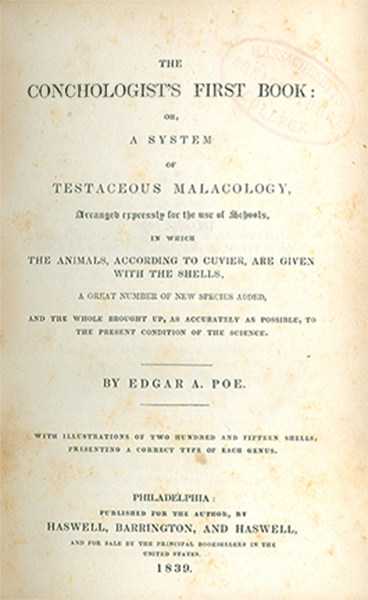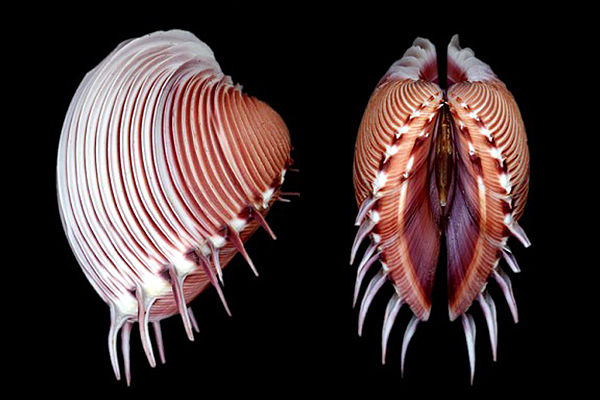
"To earn a respected place in both the Society of Antiquaries [1752] and the Royal Society [1747] was not, in the eighteenth century, an uncommon achievement; but to be then expelled from the one and sent to prison by the other is altogether rare."
Whitehead, Bulletin of the British Museum (1977)
Emanuel Mendes da Costa, a Sephardic Jew of Portuguese descent, was born in London in 1717. A member of the Royal Society, he was elected its clerk in 1763 (with a salary of Ł50 per annum), assuming responsibility for the museum and library (which were in a deplorable state), as well as housekeeper of the Society premises at Crane Court, where he had rooms. He also collected the twenty-six guinea membership fee from new Fellows, which either was paid in full or, after an initial payment of five guineas, in annual installments. (A gold guinea then was valued at twenty-one shillings—which is to say, one pound and one shilling.) It was an arrangement that allowed da Costa to accept the entire sum for membership—but register the Fellow as a subscribing member, using the remainder of the money as an interest-free loan. He then would paid the yearly fee himself or simply pocket the entire amount, hoping to pay it back sometime later. The subscriptions of more than a hundred members were thus misappropriated by da Costa to maintain his ruinous acquisition of books, shells, minerals and fossils.
He managed the fraud for almost five years, until it was discovered in 1767, when a member inquired about not being properly listed. That year alone, nearly forty subscriptions, either wholly or in part, were not conveyed to the Society Treasurer. After an inquiry, da Costa was suspended and then, at the next meeting of the Society, dismissed from his position. (Benjamin Franklin, himself a member of the Society, wrote to his son that he had attended the inquiry.) A week later, on Christmas Eve, the disgraced former clerk and his wife and child were evicted from their lodgings. Convicted of embezzling almost Ł1,500, Da Costa was sentenced to five years in debtors' prison, his second such incarceration, having been imprisoned once before in 1754, and his books and collections sold at auction. (Seemingly oblivious to the fraud, the treasurer of the Society, who had occupied the position for more than three decades, was elected its president the next year.)
By lecturing and translating, revising and cataloging (and with presumed financial help from friends), da Costa managed to repay his debt and in 1776, four years after his release, published Elements of Conchology (the first documented use of the word) to favorable reviews and, two years later, a book on British conchology. Incredulous that he had been sentenced in the first place and still unrepentant, da Costa pitied himself as "a poor devil of an author," complaining with unconscious irony that he did not receive payment from subscribers, which "sour'd my temper & depress'd my spirits." He continued to maintain some association with the scientific and antiquarian communities, catalogued the collections of others, dealt in shells and fossils, perhaps lectured—but resolved to write no more and died in penury in 1791.
In the Preface to Elements of Conchology, da Costa explains that his interest in fossilized specimens had prompted an interest in shells, themselves, and eventually a series of public lectures, which, "not meeting with the desired encouragement," were compiled into a treatise on the subject. But, before enumerating the errata in the book, he felt compelled to express a particular and unexpected concern.
"One subject, however I shall insist upon; that is, to explode the Linnćan obscenity in his characters of the Bivalves; not only for their licentiousness, but also that they are in no ways the parts expressed. Science should be chaste and delicate. Ribaldry at times has been passed for wit; but Linnćus alone passes it for terms of science. His merit in this part of natural history is, in my opinion, much debased thereby; and I can compare these his terms only to Spintrić [erotic bronze tokens struck during the reign of Tiberius], in a valuable collection of Roman coins. I therefore with due submission recommend to that otherwise great naturalist, to change them, and expunge this reproachable obscenity from his works."
He provides an instance of such obscenity in a footnote—the description of Venus dione (Elegant Venus), which he deems "fit only for the perusal of a profligate Aretin, or Rochester." The Genuine and Remarkable Amours of the Celebrated Author, Peter Aretin had been published that year, although it has nothing to do with the sixteenth-century Italian author Pietro Aretino. John Wilmot, the second Earl of Rochester, likely was the author of Sodom, or the Quintessence of Debauchery, a play published in 1684, as well as a number of quite lively poems.
A hundred pages later, as da Costa prepared to discuss his own, non-Linnean arrangement of shells, the taxonomic description of his predecessor still weighs upon him.
"It is necessary to avoid the affected conciseness and quaint terms so much in fashion, and only to use the proper language and established terms. Linnćus, otherwise the great ornament of natural historians, is very blameable in this respect...I am the more desirous of fixing technical names, as the unjustifiable and very indecent terms used by Linnaeus in his Bivalves may meet their deserved fate, by being exploded with indignation; for [in the words of the fourth Earl of Roscommon]
Immodest words admit of defense,
And want of decency is want of sense.These my terms being adopted, will render descriptions proper, intelligible, and decent; by which the science may become useful, easy, and adapted to all capacities, and to both sexes."
Another forty pages, and da Costa still feels obliged "to settle the technical terms or names for the parts of Bivalves, useful for making their descriptions intelligible and easy, as also decent; for I hold in great detestation the obscene terms made use of by the Linnean School." Here, he refers to Systema Naturae (12th ed., 1767, pp. 1069-1070), where the offensive words again occur.
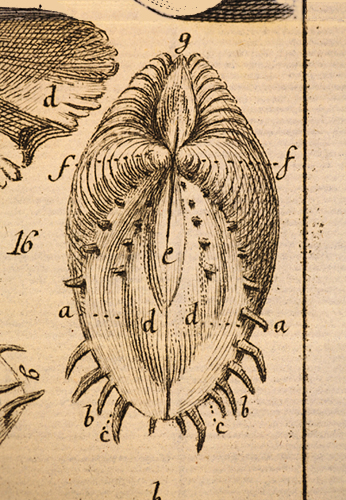
To be sure, in perusing the nomenclature of Venus dione in Linnaeus' Systema Naturae (10th ed., 1758, no. 274, p. 684-685; also 12th ed., 1767, no.112, pp. 1128-1129), one is startled by his description. What is disquieting is that words usually associated with the anatomy of the human female, such as vulva, anus, nates, pubes, montis veneris, labia, hymen, strike a discordant note in the description of a clam. On the other hand, a word such as fornicata, seemingly so salacious, simply means "vaulted."
Linnaeus' description of Venus dione is even more vivid in his Fundamenta Testaceologiae ("Foundations of the Study of Mollusks"), published in 1771. Gould regards it as "one of the most remarkable paragraphs in the history of systematics." After stating that the hinge joining the two valves of the clam shell is a defining characteristic, Linnaeus writes Protuberantiae insigniores extra cardinem vocantur Nates, "the notable protuberances above the hinge are called buttocks" (§ IX, p. 30). The adjacent parts then are enumerated, each after the female's sexual anatomy ut Metaphora continuetur ("so that the metaphor may be continued"). Above the nates (what now is termed the umbones) is the anus (lunule). Below are the hymen (the ligament connecting the two valves), vulva and labia (escutcheon), and pubes, culminating in the mons veneris. In Table II, Figure 16, these parts all are identified by an accompanying illustration (above): a is the vulva; d, the inner labia; e, the rima, "the narrow slit" of Juvenal (Satires, III.97); f, the nates; and g, the anus. To the astonished reader, it all must have seemed a ribald testaceological jest.
Although Linnaeus provided the first systematic morphology of the bivalve in his Systema Naturae (10th ed., 1758), such overtly sexual terminology was offensive to many, and there were attempts to provide an alternative vocabulary. The French naturalist Georges Cuvier says that it was da Costa, "as it would appear, who proposed to change the terms, which in reality are somewhat obscene, especially when translated into any modern language, which were imagined by Linnćus to designate certain parts of the bivalve shells." As da Costa so vehemently protests, the names used by Linnaeus to describe Venus dione simply "are in no ways the parts expressed." Instead of labia and vulva, he suggests slopes or declivitas for the lunule and escutcheon, and beaks or umbones for nates. And, to be sure, supposed visual similarities can lead to false suppositions about casual likenesses that simply may not exist.
In 1803, when two British conchologists reviewed the work of earlier authors, there still was considerable unease with the phrasing of Linnaeus, as they so ponderously explain.
"In regard to the terms and peculiar descriptive manner adopted by Linnaeus in this part of his labours, they are no less surprising for their happy expressiveness, appropriateness, and utility of application, than in other departments of the science of nature, to which he gave the same new aspect and stability of reformation. They constitute a language of his own,—a language so eminently subservient to the purposes for which it was calculated, that it would alone be sufficient to mark the superior genius of Linnaeus. At the same time we cannot hesitate to confess, that a few of these terms, however strongly they may be warranted by the similitudes and analogies which they express, and which when so pointed out are of great advantage to the language of science, are not altogether reconcilable with the delicacy proper to be observed in ordinary discourse; nor are they such, perhaps, as should be employed on any occasions, except those when their original signification is immediately implicated. Yet these terms may be exchanged for others without detriment to the Linnean phraseology in general; and though none probably more expressive can be adopted for the respective purposes, they may be abolished without any great disadvantage to those generic definitions into which they have been introduced" (pp. 180–181).
Even by 1824, a Supplement to the Encyclopćdia Britannica, in its discussion of conchology, chastises Linnaeus for his description of the genus Venus and for having "indulged in obscene allusions." Indeed, "It is now time that the pages of natural history were freed from such pollution. Other names, more expressive, can easily be substituted, alike advantageous to the interests of science, and the reputation of the illustrious Swede." This distress can be better understood when one looks at several eighteenth-century illustrations of the shell.
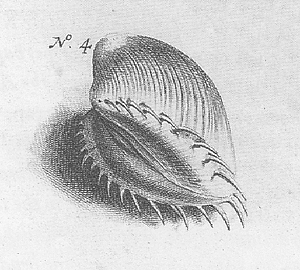
Dione was the mother of Aphrodite (Venus), and Julius Caesar himself was called Dionaeus by Virgil (Eclogues, IX.47) from Caesar's claim to have descended from the goddess through his ancestor Aeneas. And Venus dione was the species used by Linnaeus in 1758 to describe the genus Venus. A particularly handsome bivalve from the West Indies, the shell is characterized by its lavender and white color and two rows of long radial spines at the posterior end of the valves. In the Systema Naturae, Linnaeus cites the image above from Rumphius' The Ambonese Curiosity Cabinet (1705, Plate XLVIII, No. 4), upon which the editor had remarked, "This one is the true Venus Shell with Hair."
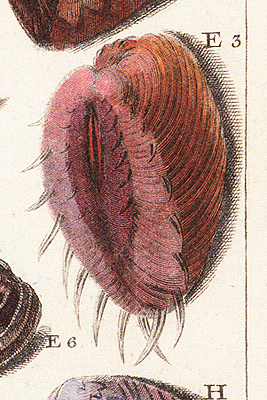
Even more anthropomorphic is this illustration from d'Argenville's La Conchyliologie (1765, 3rd ed., Plate XLVII), the spines eliciting the disquieting image of the vagina dentata, a term coined by Sigmund Freud to denote the male's subconscious fear of castration upon first seeing the vulva. "Probably no male human being is spared the terrifying shock of threatened castration at the sight of the female genitals." Discovering that a woman has no penis, the man is fearful that his own can be lost as well. The perceived similarity between the vulva and a devouring mouth (cf. Shaw's "ringent mouth" below) must have been an unnerving association.
Given the similarity of shape and color, the Latin concha (mollusk or shell-fish) was a synonym in ancient literature for the female pudendum (from pudere, "to be ashamed"). It also was an artistic convention in the depiction of Venus herself. In Rudens ("The Rope") by the Roman playwright Plautus, a character remarks te ex concha natam esse autumant, cave tu harum conchas spernas (Act III, Scene iv, 704): since Venus is said to have been born from a shell, so the goddess should not neglect the "shells" of the two young women who have sought protection at her altar. (In the Loeb edition, the translation is fussily translated as "Folks say you were born of an oyster: don't be above mothering these pearls.")
Of less psychological or prurient interest but nevertheless intriguing, Martin-Kaye once counted at Cocos Bay on the east coast of Trinidad hundreds of specimens of the Royal Comb Venus, another name for Venus dione, which also was called Pitar dione and now Hysteroconcha dione. He found a significant difference (almost 4:1) in the relative number of right and left valves washed ashore. At the southern-most end of the bay, 87% of the shells were the right valve; at the northern, only 11%. He postulated that the opposite symmetry of the spines on each valve possibly favored a slightly different direction to shore, the spines one side of the shell or the other affecting how it was sorted by tides and currents.

But not everyone who gazed upon a Venus dione was so ready to perceived anything untoward. In The Naturalist's Miscellany (1794, Vol. 5, Pl. 163), for example, Shaw, in spite of the vivid rendering by the illustrator, saw only an innocuous eye or gaping mouth.
"The rare and curious shell represented on the present plate is numbered amongst the most valuable articles of the conchyliological cabinet, and is indeed considered, when in its complete and unblemished state, as one of the cimelia of modern museums. It is, however, not often that specimens can be obtained which have not suffered some accidental injuries, especially those which have attained their full size. The Venus Dione is a native of the American seas, and was first described and figured by Bonanni[.] Its general colour is a very pale or whitish pink; each valve is marked externally by a great number of sharpened concentric zones or prominent ribs: the hinder or flattened part is of a purple tinge, more or less deep in different individuals, and is ciliated on each side with a row of curved spines, so as to give the shell, when viewed in a transverse direction, an appearance not ill resembling that of an eye, or even of the ringent mouth of a quadruped."
"Writers have not been wanting to decry this study as frivolous or inessential; most unjustly assailing the science itself, on account of the gross abuses which have now and then arisen from its exclusive and extravagant pursuit. They have reasoned much after this fashion:—that Conchology is a folly, because Rumphius was a fool. The Conus Cedo Nulli has been sold for three hundred guineas; and the naturalist just mentioned gave a thousand pounds sterling for one of the first discovered specimens of the Venus Dione (of Linnćus). But there have been men in all ages who have carried to an absurd, and even pernicious extreme, pursuits the most ennobling and praiseworthy."
The Conchologist's First Book: A System of Testaceous Malacology (p. 6)
The Conchologist's First Book: A System of Testaceous Malacology (1839) is the only book in Poe's name ever to enjoy a second edition (1840) and the best selling book in his lifetime. But he was not its author—or not substantially. The year before, his friend Thomas Wyatt had published his own book, The Manual of Conchology, a lavishly illustrated volume that, at $8, was too expensive to be sold at Wyatt's lectures. Nor would the publisher countenance a cheaper version, which would inhibit the book's already moribund sales. But if Poe would serve as Wyatt's surrogate, adding his name to an abridged volume and collaborate in its preparation, Wyatt would give him a one-time payment of $50 for the hackwork—an agreement which Poe accepted.
Although the Preface is his own, the Introduction borrows largely from that of an earlier English textbook on conchology by Thomas Brown published in 1837. Its twelve illustrative plates were, with some rearrangement, copied in their entirety, as was the "Explanation of the Parts of Shells." Copyright was infringed, to be sure; but there was no effective international copyright in any event, and a book published in a foreign country could legally be appropriated in the United States. Poe later was accused of plagiarism, which he indignantly denied. Writing a friend, he defended the arrangement with Wyatt, "my name being put to the work, as best known and most likely to aid its circulation. I wrote the Preface and Introduction, and translated from Cuvier, the accounts of animals etc." Fluent in French and well trained in classical languages, Poe would not have been daunted reading Georges Cuvier, the renowned French naturalist and anatomist. But he bristled at the charge of appropriation, reiterating that his descriptions had been "according to Cuvier," as was acknowledged on the title page.
Gould (himself a conchologist) does offer a defense of The Conchologist's First Book, in spite of its plagiarism. The arrangement of material was improved but, more importantly, the mollusk itself was described, not simply the shell that was created to protect itself. As Poe declares in his Preface, "the relation of the animal and the shell, with their dependence upon each other, is a radically important consideration in the examination of either." This is the book's "ruling feature—that of giving an anatomical account of each animal, together with a description of the shell which it inhabits." Linnaeus, the plagiarized Brown, even Wyatt himself in his earlier volume—all had described and organized mollusks simply by their shells. Even if Poe did little more than append Cuvier's description of the mollusk to that of its shell, describing both together was, as Gould contends, "the central, and surely admirable, feature of The Conchologist's First Book."
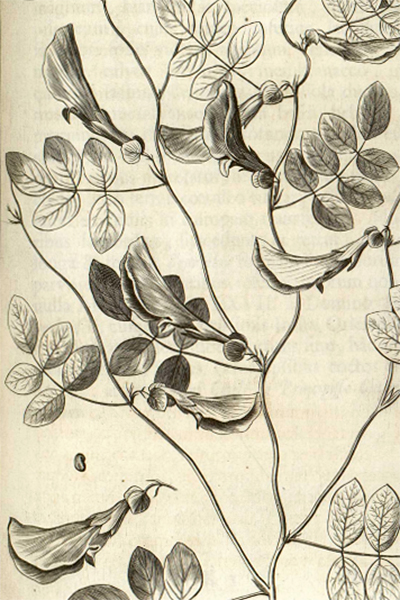
This detail is from Exoticarum aliarumque minus cognitarum plantarum centuria prima (1678, Chap. XXI, pp. 76–77) by the botanist Jacob Breyne. It illustrates an exotic blue cultivar found on the island of Ternate in the Moluccan archipelago which, because of the fancied similarity of the flower's wings and keels (its alae and carinae) to the female clitoris, he called Flos clitoridis ternatensibus ("The Clitoral Flower from Ternate")—the word itself possibly deriving from the Greek kleiein, "to close, sheathe, shut" (as the OED suggests) or kleis, "key." Given its affinity in appearance, the flower was thought to be an aphrodisiac but also traditionally was used as a medicinal, blue dye, ornamental, and food source.
Although this description and illustration of the flower served as the type species of the genus, it was Linnaeus who first used Clitoria as the generic name (Hortus Cliffortianus, 1737) and then Clitoria ternatea as the binominal (Hortus Upsaliensis, 1748). Finally, he established Clitoria as the genus, recognizing Clitoria Ternatea as the first of four species, its habitat in the Indies (Species Plantarum, 1753, Vol. II, p. 753). And this has remained the official nomenclature of the genus—to the consternation of many but no doubt to the perverse delight of Linnaeus himself.
In 1654, as a member of the Dutch East India Company (VOC), Rumphius (the Latinized form of Rumpf) settled on Ambon, another island in the Moluccas (the fabled Spice Islands) in present-day Indonesia. There he remained, studying its flora and fauna, until his death in 1702. In The Ambonese Herbal, he describes the Flos coeruleus or "Dark-Blue Flower" (a Latin translation supplemented the original Dutch). "But it really has other names that are rather immodest," as Rumphius confesses, including in Dutch De blaauwe Clitoris-bloem, "The Blue Clitoris Flower" (Herbarium Amboinense, V.30, p. 56). And yet, he still is discomfited and uses the euphemism "that part of the Female conch" for the anatomical term.
Even though the descriptions of Rumphius predates that of Linnaeus, it was not binominal, the accepted scientific standard, and so could not be used for the flower's taxonomy. Nor did he arrange his plants in taxonomic groups but by botanical description (trees, shrubs, and herbs), describing similar plants together.
C. Ternatea is papilionaceous, and its resemblance to a butterfly has given the flower its more popular name—the Butterfly Pea.
In 1753, the year after da Costa had been elected to the Society of Antiquaries, Parliament passed the Jewish Naturalization Bill or "Jew Bill," as it came to be known. It elicited an immediate public outcry, its opponents defaming Jews and agitating the profound religious and political divisions of Eighteenth-Century Britain. There were scurrilous pamphlets and anxious sermons, insults and harassments in the streets, even murder. Six months later, the Act was repealed. Although born in London, such public commotion must have distressed da Costa.
The shell specimen (top), the orientation of which has been reversed, is from Venezuelan waters and measures only one-and-a-half inches in length. It comes from ViaNet Conchology. The title page of Poe's book is from the library of the Massachusetts Agricultural College.
The illustration from Linnaeus has been photographed from Fundamenta Testaceologić (1771) in the Bancroft Library at the University of California, Berkeley, and would seem to be the first to appear on the Web.
References: Elements of Conchology: or, An Introduction to the Knowledge of Shells (1776) by Emanuel Mendes da Costa; "The Rise and Fall of Emanuel Mendes da Costa: A Severe Case of 'The Philosophical Dropsy'?" (2001) by Geoffrey Cantor, The English Historical Review, 116(467), 584-603; "The Anatomy Lesson: The Teachings of Naturalist Mendes da Costa, a Sephardic Jew in King George's Court" (1995) by Stephen Jay Gould, Natural History, 104(12), 10-15, 62-63; "The Jew of Crane Court: Emanuel Mendes da Costa (1717-91), Natural History and Natural Excess" (2000) by G. S. Rousseau and David Haycock, Historical Society, 38, 127-170; "Emanuel Mendes da Costa (1717-91) and the 'Conchology, or Natural History of Shells'" (1977) by P. J. P. Whitehead, Bulletin of the British Museum (Historical Series), 6(1), 1-24; Fundamenta Testaceologić (1771) by Carl von Linné [as Linnaeus was known when he was ennobled]; "An Historical Account of Testaceological Writers" (1804) by William George Maton and Rev. Thomas Rackett, Transactions of the Linnaean Society of London, 7(1), 119-244; Shell Collecting: An Illustrated History (1966) by S. Peter Dance; The Ambonese Curiosity Cabinet: Georgius Everhardus Rumphius (1999) translated by E. M. Beekman; The Ambonese Herbal: Georgius Everhardus Rumphius (Vol. 3) (2011) translated by E. M. Beekman; The Mollusca and Radiata (1834) by Baron [Georges] Cuvier, Edward Griffith, and Edward Pidgeon; The Naturalist's Miscellany: or Coloured Figures of Natural Objects; Drawn and Described Immediately from Nature (1789-1813) by George Shaw, figures by F. P. Nodder; Antoine-Joseph Dezallier d'Argenville: Shells (2009) by Veronica Carpita, Rainer Willmann, and Sophia Willmann; "Fetishism" (1927) by Sigmund Freud, Collected Papers (Vol. 5: Miscellaneous Papers, p. 201); "Sorting of Lamellibranch Valves on Beaches in Trinidad, B.W.I" (1951) by P. Martin-Kaye, Geological Magazine, 88(66), 432-434; "On the Nature and Definition of the Lunule, Escutcheon and Corcelet in the Bivalvia" (1967) by R. M. Carter, Journal of Molluscan Studies, 37, 243-263; "Plautus' Rudens: Venus Born from a Shell" (1974) by Eleanor Winsor Leach, Texas Studies in Literature and Language (Special Classics Issue), 15, 915-931; The Conchologist's Text Book (1837) by Thomas Brown; The Conchologist's First Book: A System of Testaceous Malacology (1839) by Edgar Allen Poe; "Edgar Allen Poe: Conchologist" (2009) by Tom Eichhorst, American Conchologist, 37(4), 19-21; "Poe's Greatest Hit" (1993) by Stephen Jay Gould, Natural History, 102(7), 10-19; "The Jew Bill of 1753: Masculinity, Virility, and the Nation" (2006) by Dana Rabin, Eighteenth-Century Studies, 39(2), 157-171; A Monograph of the Genus Clitoria (Leguminosae: Glycineae) (PhD thesis) (1977) by Paul R. Fantz.
